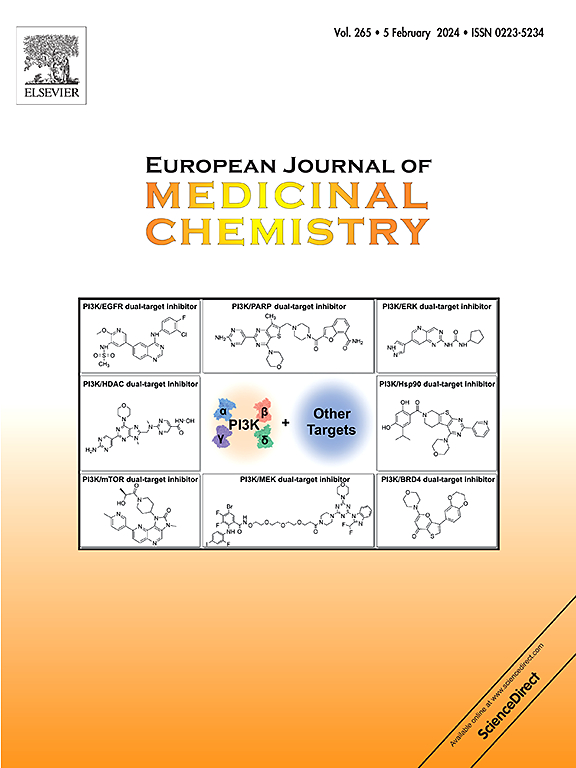优化的2,2'-二聚胺-芦桃卡松季铵衍生物:靶向细菌膜破坏增强抗耐甲氧西林金黄色葡萄球菌(MRSA)活性
IF 6
2区 医学
Q1 CHEMISTRY, MEDICINAL
引用次数: 0
摘要
抗生素耐药性的威胁不断升级,需要采取创新战略来对抗耐多药病原体。本研究通过结构模块化优化,合理设计了两亲性的芦果卡松衍生物,旨在提高其抗菌效果。含有2,2′-二聚胺基团的季铵衍生物IV4是最有效的候选药物,对耐甲氧西林金黄色葡萄球菌(MRSA)具有显著的活性,MIC值为2 - 4 μg/mL,具有快速的杀菌动力学,有效的生物膜根除和出色的血浆稳定性。低溶血活性(HC50 >;640 μg/mL),对哺乳动物细胞的细胞毒性最小。在小鼠皮肤感染模型中,IV4在减少细菌负荷和减轻炎症而无全身毒性方面优于万古霉素,突出了其强大的治疗潜力和良好的安全性。机制研究表明,IV4特异性结合细菌膜上的磷脂酰甘油(PG),导致膜破坏,活性氧(ROS)过量产生,代谢崩溃,最终导致细菌细胞死亡。总的来说,这些发现表明IV4是一种有前途的膜靶向抗菌剂,它结合了有效的抗mrsa活性和良好的生物安全性,为解决抗菌素耐药性提供了一个新的框架。本文章由计算机程序翻译,如有差异,请以英文原文为准。


An optimized 2,2′-dipicolylamine-rutaecarpine quaternary ammonium derivative: targeting bacterial membrane disruption for enhanced anti-methicillin-resistant Staphylococcus aureus (MRSA) activity
The escalating threat of antibiotic resistance necessitates innovative strategies to combat multidrug-resistant pathogens. Herein, we reported the rational design of amphiphilic rutaecarpine derivatives through structural modular optimization, aiming to enhance antibacterial efficacy. A quaternary ammonium derivative IV4, bearing a 2,2′-dipicolylamine group, was found to be the most potent candidate, exhibiting remarkable activity against methicillin-resistant Staphylococcus aureus (MRSA) with MIC values of 2–4 μg/mL, demonstrated rapid bactericidal kinetics, effective biofilm eradication, and exceptional plasma stability. Its superior selectivity was evidenced by low hemolytic activity (HC50 > 640 μg/mL) and minimal cytotoxicity toward mammalian cells. In a murine skin infection model, IV4 outperformed vancomycin in reducing bacterial load and attenuating inflammation without systemic toxicity, highlighting its strong therapeutic potential and favorable safety profile. Mechanistic studies revealed that IV4 specifically binds to phosphatidylglycerol (PG) on bacterial membranes, leading to membrane disruption, excessive production of reactive oxygen species (ROS), and metabolic collapse, ultimately resulting in bacterial cell death. Collectively, these findings establish IV4 as a promising membrane-targeting antibacterial agent that combines potent anti-MRSA activity with favorable biosafety, offering a novel framework for addressing antimicrobial resistance.
求助全文
通过发布文献求助,成功后即可免费获取论文全文。
去求助
来源期刊
CiteScore
11.70
自引率
9.00%
发文量
863
审稿时长
29 days
期刊介绍:
The European Journal of Medicinal Chemistry is a global journal that publishes studies on all aspects of medicinal chemistry. It provides a medium for publication of original papers and also welcomes critical review papers.
A typical paper would report on the organic synthesis, characterization and pharmacological evaluation of compounds. Other topics of interest are drug design, QSAR, molecular modeling, drug-receptor interactions, molecular aspects of drug metabolism, prodrug synthesis and drug targeting. The journal expects manuscripts to present the rational for a study, provide insight into the design of compounds or understanding of mechanism, or clarify the targets.

 求助内容:
求助内容: 应助结果提醒方式:
应助结果提醒方式:


